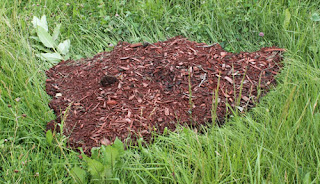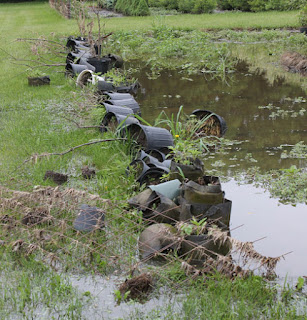We started digging garlic Friday, beginning at the south
end. It was nasty, mucky work. I loosened the bulbs with a pitchfork and tossed
them to the grass, where Hilda cut off the roots and associated clump of mud.
Shaking the roots free of the soil was out of the question. About 2/3 of the
way to the north, the soil seemed dry enough that rotting was not imminent. We
stopped. I was spent, and we still had to hose them off and hang them up.
I mentioned earlier that I was feeling pretty low Saturday
morning. We’d been cleaning up wet, muddy messes for days while we waited to
see what would and would not survive in the garden. I went out to do my chicken
chores at 6:00. I noticed that the brown box was still wet and had some nasty
looking stuff in the bottom. I took everything out with the intention of giving
it a good rinse. It seemed like an easy enough task, but it was complicated by
the fact that the lid is attached and does not open all the way. So when it
came time to flip it over to drain it, I had a problem. I pulled over a little
patio table to elevate the box so the lid would be out of the way when I turned
it over. I didn’t think to close the box before lifting it, and in the process
the lid fell on my face, knocking my glasses off my nose.
When my mother reads this, she will think, “Why didn’t you
ask me to help?”
And I will respond right here, “I didn’t know the lid was
going to fall on my face, did I?”
Fortunately, there was neither blood nor bruising. It did
nothing for my crappy mood however. I cried a little when I told Jane about my
morning, my garden, my miserable, sucky, mud-filled life. Good friend that she
is, she only laughed briefly when I told her about dropping the lid on my face.
The Bee Blitz was a good diversion. I felt perkier by the
afternoon.
It was dry enough Monday that I got out for a good
assessment of the damage. Hilda helped me pull off the row cover and roll it
up. The should-haves don’t count, but I should have done it right away. It
might have helped it dry out. The news was not good. Here is a picture showing
the green north side of the garden fading to the brown south side. In my
infinite wisdom, I planted three pattypan squash on the north and the zucchini
to the south. The pattypans look great. The first of five zucchinis looks okay.
The second is severely stunted.
 |
| Summer squash, left, with healthy pattypans and struggling zucchini. Beans, right. |
The last three are not just merely dead, but really most
sincerely dead. Note that the amaranth looks just fine.
 |
| Former zucchini with dried, mud-covered leaves splayed out in all directions. |
Take a guess: of zucchini and pattypan, which variety of
summer squash does Terry love, and which one will he not even try?
The beans suffered a similar fate, although the survival of the
north end is more tenuous. These are the beans at the south end.
 |
| Drowned beans |
The cantaloupe looked amazing! Even the ones that had been
underwater for a day looked fine. Who knew they were so robust?
 |
| Cantaloupe resilence |
Same story with the tomatoes. The north tomatoes were
recovering their turgor.
 |
| Tomato (and eggplant in back) on the north side |
To the south, we had lost 12 to 14 of the 36.
 |
| Tomato on the south side |
We finished harvesting the garlic on Monday. Here is Hilda cutting away the
mud. As you can see by the ones on the ground, the clumps were still
considerable.
 |
| Hilda cuts mud away from garlic roots |
The cleaned garlic went in a muck bucket for transport.
 |
| Big bucket o'garlic |
And here it all is, washed, bundled, and hung to dry. At
least we have garlic.
 |
| Garlic hanging to dry |
I worked in the garden pulling weeds and trimming the dead
leaves off the beans. I only got through the north half of two rows. I thought maybe they might pull through. It seemed
like the buds were still viable.
I gave up on the beans to see what was going on with the
coles. We had some pretty good looking cabbages, but about half were dead. There
were more Brussels sprouts among the weeds than I thought at first glance. We
had direct seeded some of them, and I thinned them down to one. I wished that I
could have transplanted the extra, but I know better. I’ve done that experiment
before
While I was pulling weeds, Hilda was seeking out
replacements for the dead tomatoes. She came home with these, which are leggy,
but alive.
 |
| Replacement tomatoes |
Somehow, optimism returned. We've lost 30 or so days of the growing season. If we have a late fall...I started soaking beans Monday
night to sprout on paper towels for planting as soon as I could get the rows
cleaned up. Tuesday found me going through the leftover plants at Klein’s like
a sailor on shore leave. I bought two kinds of cabbage (6 each), 3 kale, and 4
zucchini plants. I also found some fennel that purported to be good for seed.
Seed fennel is hard to find, as it seems most people grow it for the bulb.
 |
| Replacement cabbages and kale |
I got home in the afternoon just before we got 2.8” of rain
in 2.5 hours with the ground still saturated and the creek barely contained in
its banks. Another flood. Not as bad, but demoralizing, nevertheless. I just
kept telling myself that we wouldn’t lose anything that wasn’t already dead. When
I said that to Hilda, she responded, “Are you sure? Have you seen the garden?”
“Fine,” I said, “you worry about that and see how much good
it does.”
Luckily, she laughed rather than being offended. We were all
a bit testy last night.
 |
| View to the west |
 |
| The garden underwater again |
We had another downpour a few hours later, bringing the
total rainfall to 3.4”.
 |
| Rain gauge at 8:15 p.m. |
There
was more wind with this one. One of Terry’s pear trees split and fell over. He
said it had a bad trunk to begin with, and he was going to replace it anyway.
 |
| Pear tree with split trunk |
And we’ve gotten better with practice. I watched the water
level closely. Terry and I put on our Wellies and moved everything off the
floor of the garden shed when the water was just up to the threshold. We took
the brown box out of the chicken run as a precaution.
 |
| View to the south. Note water right to the bottom of the shed door. |
Now we wait again for the ground to dry and the plants to
recover or pack it in. And all the while, I can only think of the immortal
words of my late Uncle Carl, who always knew what to say in a crisis: “Well,
God damn.”






































